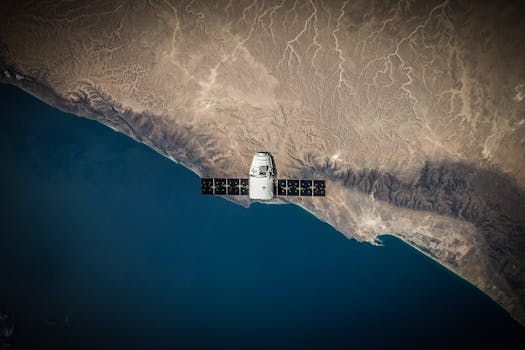
MEO Satellites: Revolutionizing Global Connectivity with Medium Earth Orbit Technology – MEO Satellites
MEO satellites, or Medium Earth Orbit satellites, are a type of satellite that operates in an orbit between 2,000 and 36,000 kilometers above the Earth’s surface. This orbit is higher than Low Earth Orbit (LEO) satellites but lower than Geostationary Orbit (GEO) satellites. MEO satellites are designed to provide a range of benefits, including improved coverage, increased capacity, and enhanced reliability. In this article, we will explore the world of MEO satellites and their role in revolutionizing global connectivity.
History and Development of MEO Satellites
The concept of MEO satellites has been around for several decades, but it wasn’t until the 1990s that the first MEO satellite systems were launched. One of the pioneering companies in the development of MEO satellites was Iridium, which launched its first satellite in 1998. The Iridium system was designed to provide global mobile phone coverage, and it paved the way for the development of other MEO satellite systems. Today, there are several MEO satellite systems in operation, including O3b, Globalstar, and Inmarsat.
Benefits and Applications of MEO Satellites
MEO satellites offer a range of benefits and applications, including improved coverage, increased capacity, and enhanced reliability. One of the primary advantages of MEO satellites is their ability to provide global coverage, including in areas where traditional telecommunications infrastructure is limited or non-existent. MEO satellites are also ideal for providing broadband services, such as internet and video streaming, due to their high capacity and low latency. Additionally, MEO satellites are used in a range of industries, including aviation, maritime, and land mobile, to provide critical communications services.
Challenges and Future Directions
Despite the many benefits of MEO satellites, there are also challenges associated with their development and operation. One of the primary challenges is the high cost of launching and operating MEO satellites, which can be prohibitively expensive for some organizations. Additionally, MEO satellites are subject to interference from other satellite systems, which can impact their performance and reliability. Looking to the future, there are several trends and developments that are expected to shape the MEO satellite industry. These include the increasing demand for broadband services, the growth of the Internet of Things (IoT), and the development of new satellite technologies, such as mega-constellations and phased arrays.
Conclusion
In conclusion, MEO satellites are revolutionizing global connectivity with their improved coverage, increased capacity, and enhanced reliability. As the demand for broadband services and critical communications continues to grow, the importance of MEO satellites will only continue to increase. Whether you are an individual, organization, or government agency, MEO satellites offer a range of benefits and applications that can help you stay connected and communicate effectively, regardless of your location or circumstances. With their unique combination of coverage, capacity, and reliability, MEO satellites are an essential part of the global telecommunications infrastructure, and their impact will be felt for years to come.
Real-World Applications of MEO Satellites
MEO satellites have a wide range of real-world applications, including providing broadband services to remote and underserved communities, supporting critical communications for emergency responders and disaster relief efforts, and enabling global connectivity for the Internet of Things (IoT). They are also used in the aviation and maritime industries to provide critical communications services, such as air traffic control and vessel tracking. Furthermore, MEO satellites are used in the land mobile industry to provide connectivity for vehicles and other mobile devices.
Technical Specifications of MEO Satellites
MEO satellites typically operate in the Ka-band or Ku-band frequency range, which provides a high level of bandwidth and capacity. They are also equipped with advanced antenna systems, such as phased arrays, which enable them to provide high-gain and directional beams. In terms of their orbit, MEO satellites are typically placed in a circular orbit at an altitude of around 20,000 kilometers, which provides a good balance between coverage and latency. The satellites themselves are designed to be highly reliable and fault-tolerant, with redundant systems and backup power sources to ensure continuous operation.
Regulatory Environment for MEO Satellites
The regulatory environment for MEO satellites is complex and involves a range of international and national agencies. The International Telecommunication Union (ITU) is responsible for allocating frequency bands and coordinating the use of satellite orbits, while national regulatory agencies, such as the Federal Communications Commission (FCC) in the United States, are responsible for licensing and overseeing the operation of MEO satellites. Additionally, there are a range of international agreements and treaties that govern the use of satellite technology, such as the Outer Space Treaty and the ITU’s Radio Regulations.
Future of MEO Satellites
The future of MEO satellites looks bright, with a range of new technologies and applications on the horizon. One of the most significant trends is the development of mega-constellations, which involve the launch of hundreds or thousands of small satellites into MEO. These constellations are designed to provide global coverage and high-capacity broadband services, and they have the potential to revolutionize the way we communicate and access data. Another trend is the growth of the IoT, which is driving demand for low-cost, low-power satellite connectivity. MEO satellites are well-positioned to meet this demand, with their high capacity and low latency making them an ideal choice for IoT applications.
Conclusion
In conclusion, MEO satellites are a critical part of the global telecommunications infrastructure, providing improved coverage, increased capacity, and enhanced reliability. With their unique combination of benefits and applications, MEO satellites are revolutionizing the way we communicate and access data. Whether you are an individual, organization, or government agency, MEO satellites offer a range of benefits and applications that can help you stay connected and communicate effectively, regardless of your location or circumstances.



